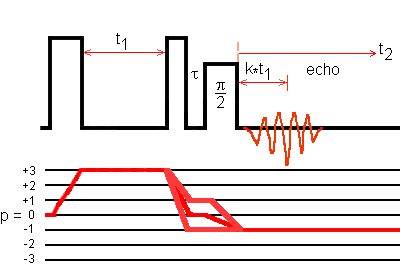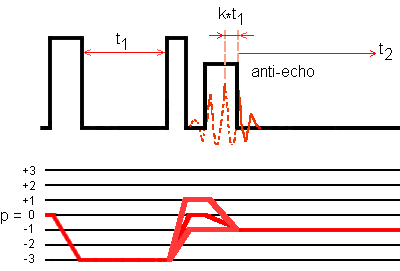
SPAM echo/antiecho pulse program for 3QMAS provided by Bruker
This NMR pulse program is for Bruker Avance III spectrometers.
Echo and antiecho parts in a 3QMAS 2D NMR experiment are acquired alternatively. Each part is obtained with a phase-modulated z-filtered MQMAS sequence combined with SPAM to increase the signal amplitude. The three pulse durations are optimized with the conventional z-filter sequence. The echo amplitude and the antiecho amplitude have opposite signs.

Fig. 1: SPAM echo transfer pathways for a spin I = 5/2 system:
0Q -> 3Q -> (1Q, 0Q, and -1Q) -> -1Q.
The phase ph1 of the first pulse is cycled 12 times.
The phase of the second pulse is X;
that of the third pulse is X. The receiver phase is -3*ph1.

Fig. 2: SPAM antiecho transfer pathways for a spin I = 5/2 system:
0Q -> -3Q -> (1Q, 0Q, and -1Q) -> -1Q.
The phase ph1 of the first pulse is cycled 12 times.
The phase of the second pulse is X;
that of the third pulse is -X. The receiver phase is 3*ph1.
After the Fourier transform with respect to t2, a t1-dependent first-order phase correction is performed with the shearing transformation.
; mp3qspam.av ; 3Q MAS pulse program for nuclei with half-integer quadrupole spin, ; experiment with z-filter: ; excitation(+3Q) - conversion(1Q, 0Q, -1Q) - tau - (+X)90°sel - ACQ(-1Q) ; excitation(-3Q) - conversion(1Q, 0Q, -1Q) - tau - (-X)90°sel - ACQ(-1Q) ; uses selective pulse added mixing (SPAM) trick, see Z. Gan; ; 90° selective pulse should be determined first using Hahn-echo, ; determination by single pulse excitation is also possible, ; then optimize P2 and finally P1 using mp3qzqf pulse program; ; 2 or more iterations for P1 and P2 may be necessary; ; for processing shearing transformation is required, ; use AU program xfshear ; parameters: ;ns : 12*n ;d1 : recycle delay ;p1 : excitation pulse at pl11 ;p2 : conversion pulse at pl11 ;p3 : 90 degree selective pulse at pl21 ;pl1 : = 119 dB (not used) ;pl11 : power level for excitation and conversion pulses ;pl21 : power level for 90° selective pulse, ca. pl11 + 30dB ;d4 : 0.5u ;d0 : = 1u or longer ;in0 : 1 rotor period for synchronized experiment ;l4: internal counter to select echo or antiecho phase cycling ;l5: number of antiechos to be acquired ;l6: =3 for I=3/2, else =1 ;td1 : number of t1-experiments ;FnMODE : Echo-Antiecho ;MC2 : Echo-Antiecho "l4=1" define loopcounter echosonly "echosonly=(td1 - l5*2)/2" ; number of remaining echos to be acquired, they ; are associated with zero-amplitude antiechos, ze ; clear memory, new data replace old data, ; switch AD converter to replace mode, ; perform DS before next acquisition, ;----------------------------------------------------------------------- ; 0Q -> 3Q -> (1Q, 0Q, and -1Q) -> -1Q signal acquisition alternating ; with 0Q -> -3Q -> (1Q, 0Q, and -1Q) -> -1Q signal acquisition ;----------------------------------------------------------------------- 1 10m d1 ; recycle delay, 10u pl11:f1 ; 10 microsecond delay, ; set high power in f1 channel, (p1 ph1):f1 ; high-power excitation pulse, d0 ; delay between pulses or t1, (p2 ph2):f1 ; high-power conversion pulse, d4 ; z-filter delay, if "l4 % 2 == 1" ; % is the remainder operator; { ; 0Q -> 3Q -> (1Q, 0Q, and -1Q) -> -1Q ; coherence transfer pathway signal acquisition: (p3 pl21 ph3):f1 ; selective 90° pulse with phase = 0, go=1 ph30 ; signal acquisition with receiver phase = -3*ph1, } ; loop to 1, ns times for averaging, else { ; 0Q -> -3Q -> (1Q, 0Q, and -1Q) -> -1Q ; coherence transfer pathway signal acquisition: (p3 pl21 ph5):f1 ; selective 90° pulse with phase = 180, go=1 ph31 ; signal acquisition with receiver phase = 3*ph1, } ; loop to 1, ns times for averaging, 3u ; do not delete, 10m wr #0 if #0 zd ; delay for disk I/O, store signal, ; increase FID number, ; delete memory data, ; do not perform dummy scans ; with next acquisition, 1m iu4 ; increment loop counter l4 = l4 + 1, lo to 1 times 2 ; acquire the other coherence transfer pathway signal, 1m id0 ; increment delay d0 by in0 (t1 increment), 1o to 1 times l5 ; next experiment, loop for number of antiechos, ;------------------------------------------------------------------- ; echo acquisition alternating with zero-amplitude antiecho ;------------------------------------------------------------------- if "l6 == 3" ; spin I = 3/2 case: { ; increase FID number, that is, 1m if #0 ; skip 0Q -> 3Q -> (1Q, 0Q, and -1Q) -> -1Q } ; antiecho transfer pathway signal acquisition, 2 10m d1 ; recycle delay, 10u pl11:f1 ; 10 microsecond delay, ; set high power in f1 channel, (p1 ph1):f1 ; high-power excitation pulse, d0 ; delay between pulses or t1, (p2 ph2):f1 ; high-power conversion pulse, d4 ; z-filter delay, if "l6 == 3" ; spin I = 3/2 case: { ; 0Q -> -3Q -> (1Q, 0Q, and -1Q) -> -1Q ; echo transfer pathway signal acquisition, (p3 pl21 ph5):f1 ; selective 90° pulse with phase = 180°, go=2 ph31 ; signal acquisition with receiver phase = 3*ph1, } ; loop to 2, ns times for averaging, else ; spin I > 3/2 case: { ; 0Q -> 3Q -> (1Q, 0Q, and -1Q) -> -1Q ; echo transfer pathway signal acquisition, (p3 pl21 ph3):f1 ; selective 90° pulse with phase = 0°, go=2 ph30 ; signal acquisition with receiver phase = -3*ph1, } ; loop to 2, ns times for averaging, 3u ; do not delete, 10m wr #0 if #0 zd ; delay for disk I/O, store signal, ; increase FID number, ; delete memory data, ; do not perform dummy scans ; with next acquisition, 1m if #0 ; increase FID number, that is, skip antiecho signal, 1m id0 ; increment delay d0 by in0 (t1 increment), 1o to 2 times echosonly ; loop for number of remaining echos, exit ; end of the pulse program ph1=(12) 0 1 2 3 4 5 6 7 8 9 10 11 ; excitation pulse phase ph2= 0 ; conversion pulse phase ph3= 0 ; third pulse phase = 0° ph5= 2 ; third pulse phase = 180° ph30= 0 3 2 1 ; receiver phase for ; 0Q -> 3Q -> (1Q, 0Q, and -1Q) -> -1Q ; that is, ph30 = -3*ph1 ph31= 0 1 2 3 ; receiver phase for ; 0Q -> -3Q -> (1Q, 0Q, and -1Q) -> -1Q ; that is, ph31 = 3*ph1
The structure of the SER-data file is simple: the time domaine signals of the coherence transfer pathway 0Q -> 3Q -> (1Q, 0Q, and -1Q) -> -1Q are alternated with those of the coherence transfer pathway 0Q -> -3Q -> (1Q, 0Q, and -1Q) -> -1Q. The first file in this SER-data file is that of the coherence transfer pathway 0Q -> 3Q -> (1Q, 0Q, and -1Q) -> -1Q.